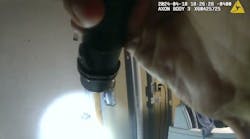There are hundreds of combinations of events that can take place during a traffic stop; the suspect can comply, passively resist, assault, run from the officer, etc. Incidents can take place near the suspect vehicle, patrol car or nearby real estate. There is no way to predict and few ways to categorize the actions that occur during a traffic stop.
Law Enforcement Technology (LET) designed a method of data collection to test officers' actions and reactions. Like any other data gathering experiment, the information will never be complete. However, findings should be shared with the law enforcement community.
Setting up the experiment
Using Airsoft pistols, provided by Pyramyd Air located in Bedford Heights, Ohio, and inert OC canisters, provided by Enforcement Technology Group Inc. of Milwaukee, Wisconsin, a team of "officers" and "suspects" were assembled in a static traffic stop scenario. An observer was placed out of harm's way with a stopwatch to ensure the results were measured and repeatable. Suspect reactions were divided into three categories consistent with the 2004 officer-assaulted traffic stop data published by the Department of Justice (DOJ): empty-handed attack, attack with firearm and suspect fled scene.
According to the 2004 DOJ data, of the 6,568 assaults on law enforcement officers, 3,889 were carried out using personal weapons (fists, hands and feet), 209 assaults were firearms related, and 2,428 were with other dangerous weapons. Thus, firearms would be appropriate in at least a quarter of officer assaults during traffic stops and less-lethal tools in more than half.
Essentially, a real-time version of a training scenario commonly found in simulators was designed. Included in the scenario is the immediacy of avoiding being hit; Airsoft rounds hurt.
Officers and suspects involved were not told what the data was for, only their options and the parameters for safety. For the experiment, the suspect was considered successful in "rushing" the officer when he could touch the officer before being subdued by OC. Successful deployment of OC meant that the officer delivered any amount of spray to the face of the suspect. Peripheral Airsoft hits were noted but not considered threat stopping.
LET understands the chosen method of data gathering took away some realism within the experiment. For example, it would be unreasonable in "real life" for an officer to remain in place when being assaulted by an unarmed assailant. However, this experiment required consistency in data and test officers were instructed to respond from their vehicle's open door to make data measurable.
From when a traffic stop is initiated to completion, every effort must be made to avoid dividing the officer's attention. For example, it should be department policy that all radio traffic describing the location of the stop be completed prior to either vehicle coming to rest. The mobile data computer should be as far to the right as to not impede an officer's quick exit. If the sun visor was down, it should be flipped up long before the stop is initiated. Better, the officer should attempt to control the stop so that the suspect vehicle faces away from the sun. This is not always feasible, but all tactical advantages should be considered.
The less encumbered by environmental factors such as traffic and pedestrians, the greater the safety of the stop. If given the option of stopping in a paved area or on an unimproved road, consider the amount of dust from two vehicles shielding aggressive moves or escape.
Response improves with intel
Response time, accuracy and information are part of a closed loop. That is, if intelligence or prior knowledge is complete, the likelihood of an appropriate response increases. If the appropriate response time is reduced, more time can be spent on target acquisition.
LET predicted that response to threats would be significantly improved if the officer knew what he was facing prior to the stop. If correct, officers faced with a known threat would deploy the correct tool and engage quicker than officers facing an unknown threat. Not only did data suggest this was true, the times were significantly faster and the hits were significantly more accurate.
During the last iterations, LET experimented with "known threat" scenarios, meaning officers were told the suspect had a firearm prior to the start of the scenario. Furthermore, the suspects were told to exit the vehicle firing. During an iteration, an officer delivered a "fatal" shot to the suspect within 0.34 seconds. In another, the same officer hit a vital area within 0.2 seconds.
First tool deployed is fastest
There is a time lag between the decision and action of an officer on a traffic stop. This time lag needs to be factored in between when an officer deploys his force option and the scenario changes. On several scenarios, the suspect quickly exited the vehicle appearing unarmed. After a couple of steps, ignoring the officer's verbal commands, the suspect drew a weapon from his clothing. During the time between a suspect's status change from "unarmed" to "armed," the suspect could cover as much as 10 feet. Sometimes the suspect was not aware that he was closing the distance on the officer.
This time lag issue is alarming. First, if the suspect moves toward the officer before drawing a weapon, the 30 feet that the officer originally had as a "cushion" has diminished by a third. Second, when a suspect randomly rushes an officer from the full distance of the traffic stop, he makes physical contact in a couple of seconds. Twice a suspect exited the vehicle and made physical contact with an officer within 1.5 seconds, once within 1.16 seconds.
This issue with time lag was the most sobering whenever a suspect exited the vehicle and rushed the officer. The officer responded to a charging suspect by drawing his weapon. By the time it appeared that the suspect was unarmed, the officer was in danger of being disarmed. Though the officer fired his weapon, scoring combat effective hits, LET recognized the danger of the officer being disarmed by the suspect. Bear in mind no one except the suspect knew what the suspect was going to do. It appeared that even if the officer exited his doorway and moved diagonally away from the suspect's direction, the distance cushion was far too diminished.
What should the officer have done to prevent firing on an unarmed suspect? Should he have moved diagonally or tangentially from the suspect's direction of travel? If the officer had, and the suspect was armed, the officer just broke from cover. If the suspect was armed with an edged weapon, the patrol car door would have been reasonable cover. Additionally, an edged weapon-wielding assailant would have been a reasonable deadly force option. If the officer decided that deadly force was not the correct force option after presenting a firearm, he would have had to make a decision within the last 10 feet of the suspect's travel. Interestingly enough, data established 10 feet was not enough cushion for OC deployment in several iterations.
Practice improves response
If LET's theory was correct, two trends would occur. Response times to threats would steadily decline, and the percentage of appropriate and effective response would increase as data collection continued. Additionally, if response times improved, accuracy would improve. As it would be unlikely officers would shoot a consistent number of rounds for each scenario, a hit/miss ratio measured accuracy, rather than the number of hits.
LET's prediction was consistently true. At the beginning of the experiment, officers fired more rounds with fewer hits. Initially, officers averaged a 1:3 hit/miss ratio. At the end of the experiment, the average rose to a 5:6 hit/miss ratio. Further, the time it took for officers to respond decreased from 1.09 to 0.66 seconds as the experiment continued, despite which officer rotated into the scenario.
Early OC deployment is best
It is hard to hit a moving target with OC. Purchasing inert OC training canisters is an excellent investment. In some scenarios, the suspect was nearly at a contact distance by the time an effective dose of OC was delivered. Also found was an improvement in OC deployment as time went on.
When suspects rushed the officer at slower than a running pace, officers gave verbal commands but did not get their OC out. This gave the suspect an advantage. Several times suspects shuffled up to the officer and ran the last few paces. OC was deployed but the officer would then be forced into additional action. The most effective response is to get the OC out early enough for a steady stream to the face.
The time for OC deployment averaged about 2 seconds throughout the test. This included draw and aligning the thumb under the cap. What changed was the accuracy of the stream and the decision-making process of the officer. If the officer got the OC out quickly, the assailant ran into the stream.
Training works
If LET were to deduce anything from these efforts, the more times scenarios were run, the better the outcome. Succinctly, training works. Nothing new, just reinforcement of what was already known.
Additionally, Airsoft training works. The products are inexpensive, work like the real thing and cost pennies to fire. Airsoft products fit the holsters and accessories of their real-life counterparts. They sting just enough for targets to be reminded why they are seeking cover. They are accurate enough to be a viable training venue. Agencies that conduct Airsoft training should consider a safety policy that includes full-face protection and appropriate clothing.
This experiment's data should not replace an agencies own investigation and data collection on traffic stops. The purpose is to continue the conversation, not circumvent training or second-guess current doctrine. LET encourages agencies to use Airsoft and inert OC to assess their own training needs.


